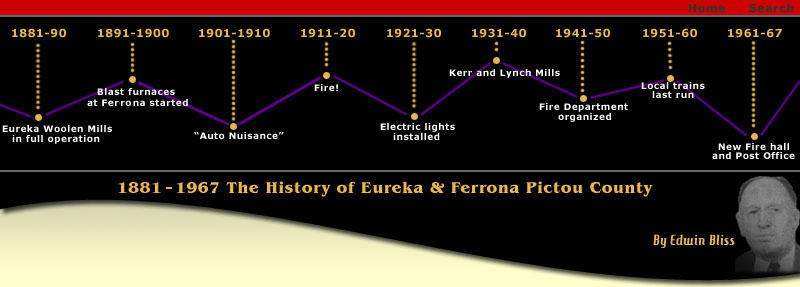1891- 1900
1891
The New Glasgow, Iron, Coal and Railway Company, issued $500,000 of
preferred first preference shares, and in April 1891, it was
announced that four-fifths of the issue had been taken up. The whole
issue of ordinary shares of $500,000, were held by the founders of
the Company. The directors were: John F. Stairs, M.P. , President;
Graham Fraser, Vice-President; the former from Halifax, the latter
from New Glasgow; William Jacks, Glasgow, Scotland; J. Walter
Allison, Halifax; and Harvey Graham, New Glasgow.
Custom facilities applied for in connection with the plant of the
Katahdens Iron Works of Maine, were purchased on behalf of the
Company, by Graham Fraser, of New Glasgow; R. J. Leckie, of
Londonderry; and Sjodett, a Swedish Iron Master, and which were to
be transferred for erection and work at the East River.
Resolutions with stipulations were granted for Right of Way and
operation to and for the Railway on the East River at or near Sunny
Brae, by the Municipal Council. In May, 1891, Tenders were called
for the construction of the Railway, from the site of the Blast
Furnaces to the terminal on the East River, estimated at 10 miles.
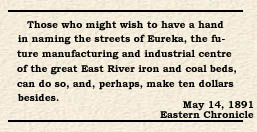 A competition was also announced for ten names for the Streets laid
out at the Town Site. The amount of the prize was $10.00. A competition was also announced for ten names for the Streets laid
out at the Town Site. The amount of the prize was $10.00.
Early in June, 1891, the Contract for building the railway from the
Furnace Site up the East River, was awarded to John McIntosh of
Stellarton and David McGregor, of McLennan’s Brook. Messrs.
McDearmitt, of Pittsburg, Pa., and Bernard Schwartz arrived and were
putting up at the Norfolk.
They were sent by Stein and Schwartz, of Philadelphia, who had the
job of erecting the Blast Furnaces. Thomas McDearmitt was to be
Superintendent of the work, and Bernard Schwartz would act as
bookkeeper. In July, 1891, the rails were laid from the I.C.R.
Junction to the site of the Bridge. Men were pouring in every day.
Real estate was selling at fancy prices.
At the last of August, 1891, the Annual Meeting was held in the
Company Office. The shareholders were served with lunch at the
Company boarding house (this, I presume, was the building later
known as the Pictou House, situated across the road from the present
homes of Clarence MacDonald and Murray Holley, it was a three storey
building, erected earlier in the year, and was being conducted by a
Mr. Potts, it could accommodate 40 boarders. The construction of the
Furnace Site was well under way, the foundations being nearly all
in, the greater part of the materials on the ground. Seven miles of
the railroad were all ready for the rails. The Meeting unanimously
agreed to give the name of “Ferrona” to their town, suggested by Dr.
Patterson, and taken from the Latin “Ferra”, meaning iron.
In November, 1891, a tour of the site showed the Stack House,
practically completed, and used as a work shop, was turning out
boiler plate for construction purposes. Three of the Blast Stoves
were almost complete. The water, was to be erected, with a capacity
of 1,000,000 gallons. The Smoke Stack, 125 ft. high by 7 ft. in
diameter was completed. The Boiler House was covered with a roofing
tile, imported from Germany, claimed to be fire-proof, very light
and economical in cost. It was the first of its kind ever to be put
on a building in the Dominion. I. Matheson & Company, of New Glasgow
had the contract for making the boilers. The Cast House was being
erected by McDonald & Falconer, of Hopewell, it was to be a three
storey building, 93 ft. by 35 ft. Part of the machinery, imported
from Germany, for the coal washing and crushing, had already arrived
and was being unloaded at the works. Coal Storage Towers were to be
erected near the coal washing buildings. Work on the Coke Ovens was
being pushed rapidly. There were to be 36 Coke Ovens, straight ovens
of the Belgium type, rather than the old fashioned bee-hive shape.
Still to be erected were: A blacksmith shop, 18x40 ft.; A carpenter
shop, 18x40 ft.; A tool house, 16x18 ft.; and an oil storage house,
18x24 ft.
The railroad at this time, Nov. 1891, was all graded and the rails
laid for two miles up the river, to where the iron bridge was being
built, crossing from the Island to the East Side of the river. I.
Matheson & Co., had the job of constructing the bridge, which was
under the superintendence of Capt. J. George Graham.
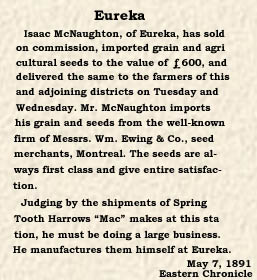 During the year, considerable activity in building, had taken place
in the village. Mr. Evan R. Fraser completed his home. Muir’s Hall
was also finished before the end of the year and a number of other
buildings were in various stages of construction. Religious Services
had been started in the dining room of Mr. Hugh Grant’s home, this
continued for a short time and then arrangements were made with Mr.
D. M. Grant to fix up a room over his store and equip it with
benches, here services were held during the summer months. When
Muir’s Hall was completed the services were moved there where they
continued until the Church was built. During the year, considerable activity in building, had taken place
in the village. Mr. Evan R. Fraser completed his home. Muir’s Hall
was also finished before the end of the year and a number of other
buildings were in various stages of construction. Religious Services
had been started in the dining room of Mr. Hugh Grant’s home, this
continued for a short time and then arrangements were made with Mr.
D. M. Grant to fix up a room over his store and equip it with
benches, here services were held during the summer months. When
Muir’s Hall was completed the services were moved there where they
continued until the Church was built.
1892
 Conditions in the village continued to flourish, with people still
flowing in. Buying and selling of land. Building houses and opening
up business of many kinds. Mr. Isaac McNaughton was still busily
engaged in the manufacture of plows and harrows and was also
importing grain and agricultural seeds from Messrs. Wm. Ewing & Co.,
Seed Merchants of Montreal, and selling them on commission. A
grocery store was opened up and operated by selling them on
commission. A grocery store was opened up and operated by Mr. Daniel
Fraser (Drummond). A tailoring establishment was started by a Truro
firm about the middle of March, 1892. The need for a School House
and a Church was being stressed. Muir’s Hall was proving to be too
small for Church purposes. The Sabbath School was increasing and
doing good work. A temperance lodge was rapidly growing in numbers
and hopes were that it would be successful in keeping the great evil
– intemperance – from Eureka and Ferrona. Conditions in the village continued to flourish, with people still
flowing in. Buying and selling of land. Building houses and opening
up business of many kinds. Mr. Isaac McNaughton was still busily
engaged in the manufacture of plows and harrows and was also
importing grain and agricultural seeds from Messrs. Wm. Ewing & Co.,
Seed Merchants of Montreal, and selling them on commission. A
grocery store was opened up and operated by selling them on
commission. A grocery store was opened up and operated by Mr. Daniel
Fraser (Drummond). A tailoring establishment was started by a Truro
firm about the middle of March, 1892. The need for a School House
and a Church was being stressed. Muir’s Hall was proving to be too
small for Church purposes. The Sabbath School was increasing and
doing good work. A temperance lodge was rapidly growing in numbers
and hopes were that it would be successful in keeping the great evil
– intemperance – from Eureka and Ferrona.
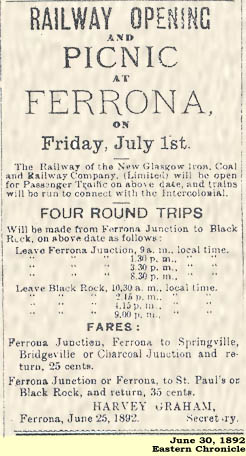 In June, the Grand Opening of the East River Railroad was announced
to take place on July 1, 1892. There was also to be a big Picnic in
connection with it. Four round trips would be run from Ferrona
Junction to Black Rock, leaving the Junction at 9 a.m.; 1:30 p.m.;
3:30 p.m.; and at 8:30 p.m. Return fares from Ferrona Junction of
Ferrona to Springville, Bridgeville or Charcoal Junction would be 25
cents. The number of excursionists proved to be much larger than was
anticipated. Joseph S. McKay, of Stellarton, was the Conductor on
the train between Ferrona Junction and Black Rock. Four trips,
daily, excluding Sundays, would continue to be run. The first part
of the big day proved to be favorable, weatherwise, but a heavy
shower in the evening dampened the ardors of the picnicers. The
handsome sum of $500.00 was cleared at the Picnic. In June, the Grand Opening of the East River Railroad was announced
to take place on July 1, 1892. There was also to be a big Picnic in
connection with it. Four round trips would be run from Ferrona
Junction to Black Rock, leaving the Junction at 9 a.m.; 1:30 p.m.;
3:30 p.m.; and at 8:30 p.m. Return fares from Ferrona Junction of
Ferrona to Springville, Bridgeville or Charcoal Junction would be 25
cents. The number of excursionists proved to be much larger than was
anticipated. Joseph S. McKay, of Stellarton, was the Conductor on
the train between Ferrona Junction and Black Rock. Four trips,
daily, excluding Sundays, would continue to be run. The first part
of the big day proved to be favorable, weatherwise, but a heavy
shower in the evening dampened the ardors of the picnicers. The
handsome sum of $500.00 was cleared at the Picnic.
In July, 1892, Mr. Thomas Fraser (Foreman), father of Graham Fraser,
was hurt by a fall, while overseeing the construction of trestle
work, for the New Glasgow, Iron, Coal & Railway Company. On August 7, 1892, Eureka Presbyterian Congregation held its
Communion. Twenty-six new members were received, eighteen by
certificate and eight by profession of faith. The Communion Service
used, was a gift from the ladies of the congregation, who
contributed $30.00 towards its purchase. A congregational meeting
was called for August 15, 1892, to take steps for the building of a
Church. The Sunday School Picnic, postponed for a week was to be
held on August 20, 1892.
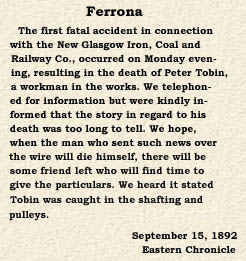 On August 24, 1892, the Blast Furnaces at Ferrona were started, and
on the following day, the Annual Meeting of the Company was held,
and the Stockholders shown through the works to see it in operation.
On Sept. 12, 1892, the first fatal accident occurred at the Blast
Furnaces. Peter Tobin, a workman was caught in the shafting and
pulleys, resulting in his death. On August 24, 1892, the Blast Furnaces at Ferrona were started, and
on the following day, the Annual Meeting of the Company was held,
and the Stockholders shown through the works to see it in operation.
On Sept. 12, 1892, the first fatal accident occurred at the Blast
Furnaces. Peter Tobin, a workman was caught in the shafting and
pulleys, resulting in his death.
In September, 1892, the Eureka Woolen Mills, apparently not living
up to expectations, were advertised for sale, and Tenders of
Purchase were called, to be received until noon of October 13, 1892.
The advertisement was signed by Duncan McDonald as Secretary, and
was dated Sept. 29, 1892. A Special Meeting of the Stockholders of
the Eureka Woolen Mill Company was held on November 11, 1892, to
consider the acceptance of an offer of purchase.
1893
On March 16, 1893, tenders were called for the excavating,
foundation walls, and the building of the Presbyterian Church, 72
ft. x 43 ft., with spire and vestry, Tenders to be open until March
28, 1893. The notice was signed by Isaac McNaughton, as Secretary;
who was also the designer of the plans for the Church. In April
1893, the contract for the building of the Presbyterian Church was
awarded to Brown Bros., Contractors and Builders of Westville.
Messrs. Duncan and Hugh G. McDonald had the contract for the
excavation and the foundation.
At the Blast Furnaces, work was being conducted day and night,
making 4 casts every 24 hours, and with an output of between 70 and
80 tons of first class pig iron daily.
The Eureka Woolen Mills were in operation with Mr. M. H.
Fitzpatrick, of New Glasgow, as Proprietor. In May 1893, he was in
Montreal on Business in connection with his Mills. Before he
returned he looked into the Electric light system of that area, with
the thought of establishing an Electric Light Company, in Hopewell.
Earlier in the year, an Orange Lodge was organized in the village
with W. M. Fraser, as W. M. Work was proceeding on both the
Presbyterian and Methodist Churches. On September 8, 1893, the
Corner Stone of the Presbyterian Church, was laid by the Masonic
Grand Lodge of Nova Scotia, of which M. W. Bro. D. C. Fraser, was
the Grand Master, and who performed the ceremony. (When the building
of the Church was proposed, offers of free sites for its location
were made. One by Mr. Robert Muir, on the sloping hill west of the
I.C.R. Railway Line. One by Dr. MacDonald, of Hopewell, not far from
the river bank, and one from the New Glasgow Iron, Coal and Railway
Company. Mr. Robert Muir favored the Eureka side, as did also Dr.
MacDonald, of Hopewell, as a number of people would be coming from
Hopewell and it would be handier for them. A great deal of heated
debate took place on the selection of a site, but logic and sound
reasoning finally prevailed for a decision on the Company site.)
In October, 1893, it was stated that twelve buildings had been
erected during the summer, six on each side of the river, with the
thirteenth, at that time going up on the Eureka side. The Eureka
School which had also been erected during the summer, was opened in
the second week of October, 1893. It comprised two departments, with
Mr. W. Allister Ross, of Lorne, as the Principal. (Mr. Foss was an
older brother of the late Rec. D. K. Ross and later studied for the
ministry, becoming Rev. W. A. Ross in 1900)
In November, 1893, there were about 300 men employed at Ferrona
Blast Furnaces and at the Iron Mines, with a pay roll averaging
$10,000 monthly. The demand for pig iron was fair but did not exceed
the supply.
The first week of November, 1893, saw the work on Zion Presbyterian
Church nearly completed, and plans were made for its opening on Nov.
18, 1893. The dimensions of the Building were 72 ft. x 43 ft., with
a vestry and tower, and a basement not to be completed for the
present. Seating accommodations provided for 500 people. Total cost
of erection $3,800. Furniture and carpets were secured from Messrs.
Gordon & Keith, through the New Glasgow agent, at reasonable cost.
Six “Pittsburgh Extension” lamps were supplied by Stewart & Co., of
New Glasgow, to light up the Church. Heat was provided by two large,
warm air furnaces, supplied by Thompson & Sutherland, of New
Glasgow. The furnaces were of the “New Giant” pattern. Zion Church
was opened on Schedule on the third Sunday of November, Nov. 19,
1893, with three services. The weather was most favorable, the
congregations large, and the services appropriate. In the morning,
Rev. A. Laird, as pastor of the Church, took possession of their new
and beautiful building, under auspicious circumstances. The opening
services were conducted by Rev. Robert Cumming, of Westville. The
afternoon services were in charge of the Orange Lodge and were
conducted by Rec. Dr. McLeod, of Thorburn, about eighty Orangemen
were present in full regalia, most of them were visitors from
Stellarton and Westville. Rev. J. F. Forbes, of Durham, had charge
of the evening services. The Choir, led by Mrs. (Dr.) Macdonald, of
Hopewell, who was an accomplished musician, used the Old Choir Book.
The Dedication Anthem from that book was most fitting as it was sung
from full hearts.
On Tuesday evening, November 28, 1893, the Methodist Church at
Eureka, was dedicated for divine service. The Ceremony being
conducted by Rev. W. H. Heartz, D.D., Truro; W. Purvis, New Glasgow;
Rev. W. G. Lane, Pictou, and W. Nightingale, of Stellarton. This
congregation was formed in 1891, by the Methodist Church of
Stellarton and was included in the Stellarton circuit.
1894
 In February, 1894, it was reported that the Ferrona Iron Works were
using coal from the mines of the Dominion Coal Co., at Glace Bay.
The New Glasgow, Iron, Coal and Railway Co., increased their rolling
stock by purchasing new railway cars from Rhodes, Curry & Co., of
Amherst. Two large trains of ore were coming in every day to the
furnaces. In February, 1894, it was reported that the Ferrona Iron Works were
using coal from the mines of the Dominion Coal Co., at Glace Bay.
The New Glasgow, Iron, Coal and Railway Co., increased their rolling
stock by purchasing new railway cars from Rhodes, Curry & Co., of
Amherst. Two large trains of ore were coming in every day to the
furnaces.
The Eureka Woolen Manufacturing Co., held their Annual Meeting at
Eureka, on February 6, 1894. A large expenditure had been made in
fitting up the Mill and supplying it with the newest and most
improved machinery so that the Mill was one of the best equipped in
the Maritime Provinces. After putting by a small amount for a
sinking fund, a dividend of 8% on the paid up Capital Stock was
declared. The Industry was again placed upon a sound and profitable
basis. Mr. J. P. McLennan, of Moncton, accepted the position of
manager of the Eureka Woolen Manufacturing Company.
In 1894, there were two public halls in Eureka, Muir’s Hall and
McKenzie’s Hall, Mr. S. K. Muir was the proprietor of the former and
Calvin McKenzie, of the latter. On April 26, 1894, the Oddfellows,
of Hopewell, held a Special Service in Zion Church, and this was
followed by a supper in McKenzie’s Hall afterwards.
On May 9, 1894, Mr. Zerkler, foreman at the coke ovens was severely
injured by being caught with the coke car. His legs were badly cut
and bruised, and it was expected that it would be some time before
he would be up and around again.
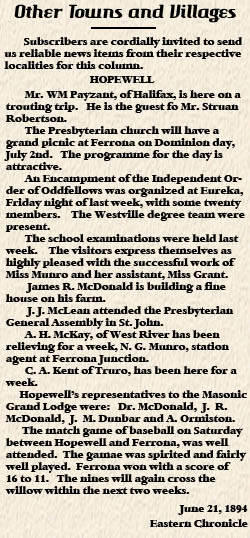 A baseball team was organized in Ferrona, and at the first Picnic of
the Season, held at Ferrona on June 16, 1894, a baseball match was
played between Hopewell and Ferrona. It was well attended and the
game won by Ferrona, by the score, 16 – 11. A baseball team was organized in Ferrona, and at the first Picnic of
the Season, held at Ferrona on June 16, 1894, a baseball match was
played between Hopewell and Ferrona. It was well attended and the
game won by Ferrona, by the score, 16 – 11.
On July 2, 1894, a Picnic was held, under the auspices of the Ladies
of Zion Church, to raise money to pay the balance of the debt on the
Church. It was a great success. The Sum of $350.00 was netted. A
baseball game between Hopewell and Eureka was won by Hopewell by 12
runs. Due to the extreme heat, the game was not the best.
Nathan Stiles was appointed trustee, at the Annual School Meeting,
in place of Kenneth McMillan, who had resigned.
In July, 1894, a motor boat was put in operation, as a pleasure
craft, on the Eureka dam, and provided quite an attraction. The dam
was about a half a mile long. The motor boat was owned by Mr.
Hingley.
A meeting of the Liberal Party of Polling District No. 17, was held
in McKenzie’s Hall, on October 26, 1894. About this time some
politicians being in the district. Mr. Robert Muir interviewed them
in reference to a booking Station at Eureka Siding.
In December 1894, the people of New Glasgow and other locations down
the river, became alarmed at the pollution of the water in the East
River, caused by the Ferrona Iron Works, and complained to the
Council that the water was totally unfit for domestic use. The
Council made an investigation and found conditions
even worse that had been reported. Great quantities of the wash from
the iron ore and coal were deposited directly in the river, giving
the water a disgusting appearance. The Company was given 15 days to
cease polluting the river or immediate steps would be taken to
prevent them. When the 15 days had expired, a delegation waited on
the Town Council and stated that the Company had no wish to pollute
the river in any manner, and were engaged in building dams and
filters for the purpose of cleaning the water before it entered the
river. This information was satisfactory to the Council. Some days
afterwards, they instructed their engineer to see what was done in
this respect. He found that a dam 450 ft. long had been constructed
along the west bank of the East River, thence turning to higher
ground and flooding about 2 ½ acres. This served as a settling basin
for the Coal washer only, and the water filtered through a swamp and
dam, entered the river comparatively clear. Other precautions were
also being taken. (I mention this protest in detail because of its
importance in a later development.)
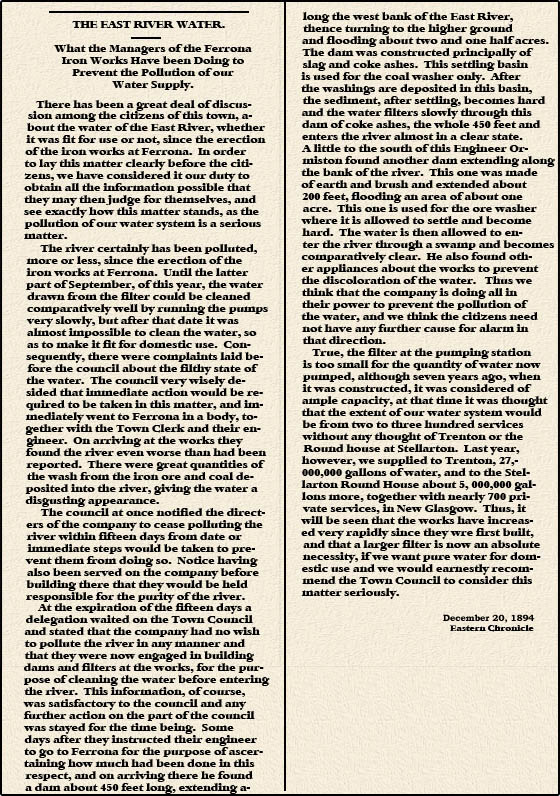
When Mr. H. K. Fitzpatrick was in Quebec in 1893, he had looked
quite extensively into the electric power development there, and was
inspired by the thought of a similar development on the East River.
On his return he set about attracting the attention of some monied
men to his scheme. The result was, the East River Electric Company,
Ltd., of Pictou County, became organized with a Capital Stock of
$30,000, in 1894. It was proposed to erect a dam, 30 ft. high, about
500 yards below the village of Hopewell, and if required, another
farther down, to assure at least 300 H. P. With this Water Power, it
was planned to supply the residents of New Glasgow, Stellarton,
Westville and Ferrona with electric light. Cost of construction was
estimated at $25,000., with running expenses at $3,500. An annual
revenue was expected of $5,500. Subscribers were being solicited for
$27,000 worth of Stock in shares of $50. each. Mr. H. K.
Fitzpatrick, Barrister, and Mr. J. A. Pickett, Civil engineer, both
of New Glasgow, apparently acquired the land and water rights,
privileges and leases, and were holding them in Trust for the
proposed Company. (As nothing further was made public on this
scheme, it would appear that the project did not advance beyond the
planning stage.)
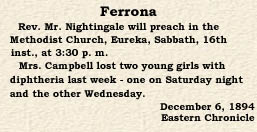
1895
Early in January, 1895, it became necessary to close the school, on
account of an outbreak of diphtheria. It was re-opened on January
28, 1895, after which two new cases appeared. In February,
diphtheria broke out again and the board of health was busy. It was
regretted that a stricter quarantine of the infected house was not
made.
The Iron Works stopped operations in January, 1895, owing to a
defect in the blast furnaces. It was variously reported that work
would not be resumed for several months, but that was uncertain. It
was said that a large mass of cold iron had lodged in one of the
furnaces preventing the molten iron from running. With the closing
down of the Iron Works, a gloomy picture was presented to Ferrona.
Many men left the place with more going. Only those with property
and families were staying. Merchants and business men were being
hard pressed.
On February 1, 1895, Guiding Star Lodge, elected and installed the
Officers for the year. G. S. Brown, Sec’y; Bella MacMillan, Chap.;
Christie Reid, D.M.; Miss Bella MacMillan, S. of J. The Lodge was
one of the best in the district. Over 50 members, with new members
joining nearly every night.
In March, 1895, the Nova Scotia Steel and Forge Company and the New
Glasgow, Iron, Coal and Railway Company were consolidated under the
name of the Nova Scotia Steel Company. In May, 1895, Mr. W. C.
Zerkler, analyst and manager of the Coal Washing and Coking Plant at
the Ferrona Iron Works, resigned his position and left for
Philadelphia. It was expected that operations at the Ferrona Iron
Works would resume about the first of June.
About this time Mr. Robert Muir reported having found a rich lead of
Copper on his property at Eureka.
In 1895, The Eureka and Ferrona Gold Mining Company was formed, and
in June, reported pushing operations at Sutherland’s River. They had
good prospects of opening up a mine. One of their leads, eighteen
inches wide, was discovered by Isaac McNaughton. The shareholders of
the Company were: Isaiah A. Morrison, David Nelson, Nathan Stiles,
D. M. Grant, Kenneth McMillan, Angus J. McDonald and William
Urquhart. In September, 1895, a meeting was called to enlarge and
strengthen the Company.
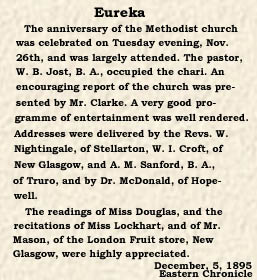 Guiding Star Lodge, I.O.G.T., gave a musical and literary
entertainment in Muir’s Hall, on Wednesday, September 11, 1895. Guiding Star Lodge, I.O.G.T., gave a musical and literary
entertainment in Muir’s Hall, on Wednesday, September 11, 1895.
Mr. Isaac Prosser was appointed new furnace manager at the Iron
Works.
The new freight shed at Eureka Siding, was nearly completed by the
contractors, Hugh McDonald & Sons, on October 1, 1895. There was
considerable speculation as to who would get the position of
Caretaker. It was opened for business in November, with the
understanding that the Caretaker would get a monthly salary of
$15.00, his appointment was not expected until after the Municipal
or Dominion Elections. The formal opening for business took place on
December 2, 1895, with Mr. Kenneth McMillan in charge.
 During Christmas week, 1895, the Merchants of New Glasgow arranged
for a Special Train to be run from Westville and Stellarton on the
afternoon of the twenty-first. Also for one to return to Hopewell
and Eureka on the evening of the twenty-fourth. During Christmas week, 1895, the Merchants of New Glasgow arranged
for a Special Train to be run from Westville and Stellarton on the
afternoon of the twenty-first. Also for one to return to Hopewell
and Eureka on the evening of the twenty-fourth.
1896
In March, 1896, it was deplored that Express Trains were not
stopping at Eureka Siding.
Early in April, 1896, it was reported that the Nova Scotia Steel
Co., had a large force of men engaged in putting new lining in their
furnaces. This was completed about the third week in April and a
fire was started to dry it. Casting was expected to resume about May
1, 1896. About the first of August, the furnaces had to be banked
for several days, on account of scarcity of men to handle the ore
brought from Newfoundland, but towards the end of the month, the
furnaces were again in operation.
In August, 1896, Mr. Robert Muir planned on opening up his Copper
Mine on an extensive scale.
New Elders appointed for Zion Church Congregation, in September,
1896, were: Newton G. Munro, Donald M. Grant and George H. McKay. At
the Anniversary Service of Zion Church, held on Sunday, November 22,
1896, a Special Collection was taken for the building fund. The
Committee asked for $100.00 and received $120.00. This left a debt
of only $625.00, on their new Church.
1897
During the month of February, 1897, a number of disconnected events
took place: The Annual Congregational Meeting of Zion Church showed
that $1,250.00 had been collected in the past year. A Concert,
consisting of Songs, Readings and the James Church Quartette, was
presented in Muir’s Hall, with 250 persons present. The Eureka
Woolen Mills put in a new washer and fuller, which cost $300.00.
James Dryden fell about 30 feet from the wash house at the Iron
Works and was considerably hurt about the head.
The second fatal accident occurred at the Iron Works, on June 1,
1897, when Joseph McNeil, a brakeman on the Company railroad, lost
his life. The cause of his death was not known, but it was supposed
that he fell between the cars. He was 23 years of age and belonged
to Beaver Cove, Cape Breton, he had been employed by the Company for
about four years.
Mrs. Ann McDonald Grant, wife of Hugh Grant, and mother of D. M.
Grant, died at Eureka, on May 30, 1897, in the 94th year of her age.
 In July, 1897, quite a number of events took place: the Ladies of
Zion Church held a Picnic on July 8, 1897, and $100.00 was cleared.
D. M. Grant and Henry Barclay were elected trustees at the Annual
School Meeting. A baseball match between Hopewell and Ferrona, on
July 24, 1897, resulted in a win for Ferrona, by the score or 23 –
20. At the end of the seventh inning the score was Ferrona 18 and
Hopewell 7, following an injury to catcher, G. E. Brown, the
Hopewell score mounted. It was reported that a rich lead of Copper
had been struck. Six feet was said to be the thickness, and the
Copper reported to be of excellent quality. In July, 1897, quite a number of events took place: the Ladies of
Zion Church held a Picnic on July 8, 1897, and $100.00 was cleared.
D. M. Grant and Henry Barclay were elected trustees at the Annual
School Meeting. A baseball match between Hopewell and Ferrona, on
July 24, 1897, resulted in a win for Ferrona, by the score or 23 –
20. At the end of the seventh inning the score was Ferrona 18 and
Hopewell 7, following an injury to catcher, G. E. Brown, the
Hopewell score mounted. It was reported that a rich lead of Copper
had been struck. Six feet was said to be the thickness, and the
Copper reported to be of excellent quality.
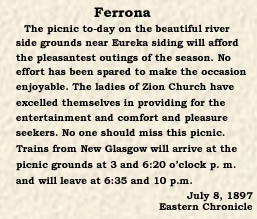 The Members of the Ferrona Iron Works Relief Fund, held a Picnic on
August 10, 1897, with excursion tickets from New Glasgow,
Stellarton, Westville and Hopewell. The Members of the Ferrona Iron Works Relief Fund, held a Picnic on
August 10, 1897, with excursion tickets from New Glasgow,
Stellarton, Westville and Hopewell.
Two interesting marriages took place in the latter part of the year,
1897. Miss Janetta J. Barclay became the bride of Mr. Sylvanus K.
Muir, on October 13, 1897, the bride was given away by her brother,
Gordon, her sister, Miss Della, acted as bridesmaid. The groom was
supported by Mr. W. A. Ross of Lorne, student at Dalhousie College.
On December 1, 1897, Ida M. Murray, of New Lairg , became the bride
of John Wesley Gillespie, of Ferrona. Both couples were married by
Rev. William McNichol, M.A.
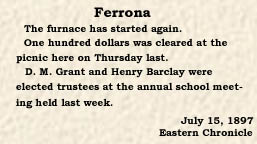
1898
In January, 1898, considerable speculation took place about the
future of the Nova Scotia Steel Company. Would the Blast Furnaces
remain at Ferrona or would they go to Cape Breton?
The Relief Fund of the Ferrona Iron Works, with James H. Reid as
Secretary-Treasurer, gave the following report in January 1898. Paid
out to one member on account of sickness, $19.20. Eight members on
account of sickness, $116.61. One death claim, $50.00. Total
indemnities, $185.81. Receipts from members contributions, $335.10;
from other sources, $313.77; total $648.87. Expenses, $209.50.
Balance on deposit in Bank of Nova Scotia, $439.28.
In February, 1898, the Eureka Woolen Mills were running at their
fullest capacity. About $800.00 was paid out monthly in wages and
employment was given to about 35 hands. The goods manufactured were
second to none and many orders had to be cancelled. Under the
efficient management of Mr. Clarke, some of the best material
manufactured in the Lower Provinces could be found in their store
room. Mr. Clarke had been manager of the Mills for the past 15
years. The office work and shipping business was in charge of Mr.
James P. McLennan. In March, 1898, the Eureka Woolen Company, sold
their Custom roll cards, and discontinued any roll carding for the
coming season.
May 1898, saw Hugh McDonald with a gang of men erecting a large
building for C. S. Clarke, of Eureka, to be used for a knitting
factory. In August 1898, the School Trustees had some difficulties
in securing teachers. In October, 1898, Mr. Newton Munro, who had
been Station Agent at Ferrona Junction, was appointed to a similar
capacity at Hopewell, to take the place of Mr. James McDonald,
deceased. In November, 1898, the Blast Furnaces at Ferrona were
reported repaired and in blast again. C. S. Clarke & Sons, had their
well appointed knitting factory in operation for the manufacture of
hosiery, with their product finding a ready market. The Eureka
Woolen Mills were running overtime to fill orders.
Tenders for the construction of the Bridge leading from Ferrona to
Churchville, were opened on March 25, 1898. The contract was awarded
to John Stewart, of New Glasgow, for $2075.00. The bridge was to be
a superstructure with 2 deck spans of 120 ft. and 80 ft.,
respectively between end pins. The Roadway, 15 ft. wide in the
clear. In November, 1898, the abutments and approachments for the
new bridge were about complete. The total and final cost of the
bridge was $2675.00.
Christmas shoppers in 1898, were faced with such prices as
advertised by B. D. Rogers & Company: 5 lbs. of mixed nuts and 5
lbs. of mixed candy for $1.00; 8 lbs of raisins, 8 lbs currents for
$1.00; 11 lbs of choice cheese for $1.00; 26 lbs of bright sugar for
$1.00; molasses, 38 cents a gallon; oil 23 cents a gallon; vinegar,
25 cents a gallon; 10 lbs beans, 5 lbs rice, 10 lbs onions, 10 lbs
apples and 10 lbs split peas, all for $1.00
1899
On February 3, 1899, a quadrille party was held in McKenzies Hall.
The Pie Social held in Muir’s Hall, on February 10,1899, in aid of
Zion Church Sabbath School, was a grand success. Mr. Evan R. Fraser
occupied the chair. Mr. George McKay, set the ball rolling by
bidding out the first pie.
Mr. Joseph Dix Fraser, son of Graham Fraser, was the Superintendent
of the Nova Scotia Steel Company’s operations at Ferrona.
On October 6, 1899, the breakwater at the Eureka Woolen Mills broke
away, during a freshet, causing a serious loss to the Company. The
Mills were running at full capacity, manufacturing first class
tweeds, woolen goods and blankets, with a large number of orders in
advance of what they had contracted for.
The members of Zion Church held an entertainment and pie social in
Mr. Calvin McKenzie’s hall, on November 13, 1899. The entertainment
consisted of readings, recitations, vocal and instrumental solos.
In November, 1899, there was exhibited a piece of chain, 3 ft. and
10 inches long, made out of one piece of birchwood, links about 1
inch each, carved by John r. Forbes, engineer at Ferrona. The chain
had a spring clasp, all wood, a perfect swivel and a hook. The
Forbes family lived in the home now owned by Mr. and Mrs. Harold
Leigh. (The writer seems to have a faint recollection of having seen
this chain years ago.)
Mr. F. W. Harley, secretary-treasurer, of the Eureka Woolen Mills,
went to Halifax, in November, 1899, to attend Supreme Court, in the
interests of the Company.
1900
In February, 1900, the Ferrona Iron Works were doing a rushing
business. Quite a lot of pig iron went to the Londonderry Works to
be made into pipe for Cape Breton.
In the Supreme Court case of Union Bank versus Eureka Woolen Mills,
Mr. Justice Henry filed judgment for the defendant, on February 27,
1900.
An article in the Presbyterian Witness, of May, 1900, read: “Among
the gifts for the Indian Famine, received sometime ago, we note
$157.25 from Ferrona – a young congregation of 72 families, with not
a wealthy man among them. A large number of the men are day
laborers. They have built a neat Church and they pay the pastor
$650.00, a year. Sacrement to the Lord’s Supper on April 29, 1900,
in Zion Church. Presbyterian Church now free of debt.”
The Ferrona Cricket Club reorganized in May, 1900, with the
intentions of doing some great playing during the coming summer.
In June, 1900, Muir and McEwan had dug about 15 feet into their
copper mine, and were anticipating good results.
A railway accident occurred at Ferrona Junction in June, 1900. The
night express struck a car loaded with limestone, which had run out
of the Nova Scotia Steel Company’s siding, at Ferrona Junction, and
across the I.C.R. track. The locomotive was thrown from the track
and completely wrecked. A bad scare was had by all and the
passengers on the train were shaken up, but no one was injured. The
car was noticed in time to avoid more serious consequences.
Mr. Evan R. Fraser was presented with a handsome writing desk, on
November 21, 1900, by the teachers of Zion Church and those
interested in Sabbath School Work.
A Basket Social was held in Muir’s Hall, on December 18, 1900, by
Zion Church Congregation.
1901-1910

|
